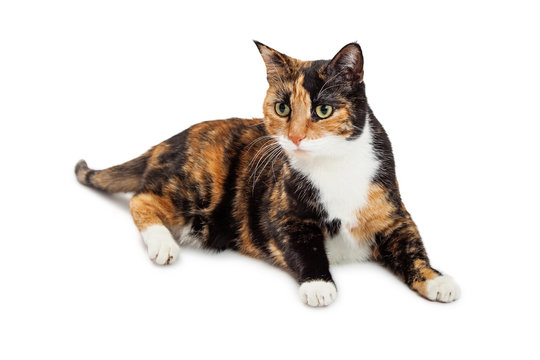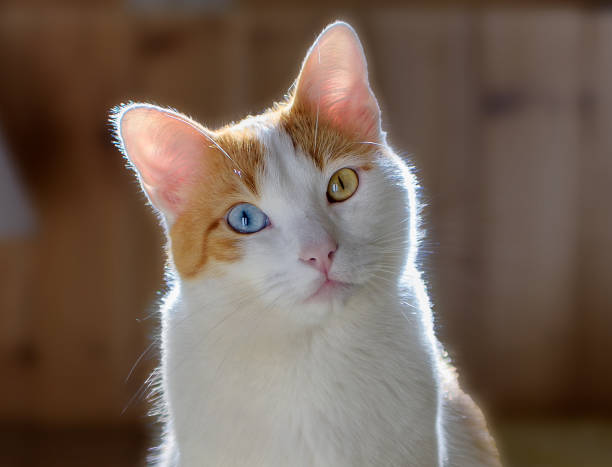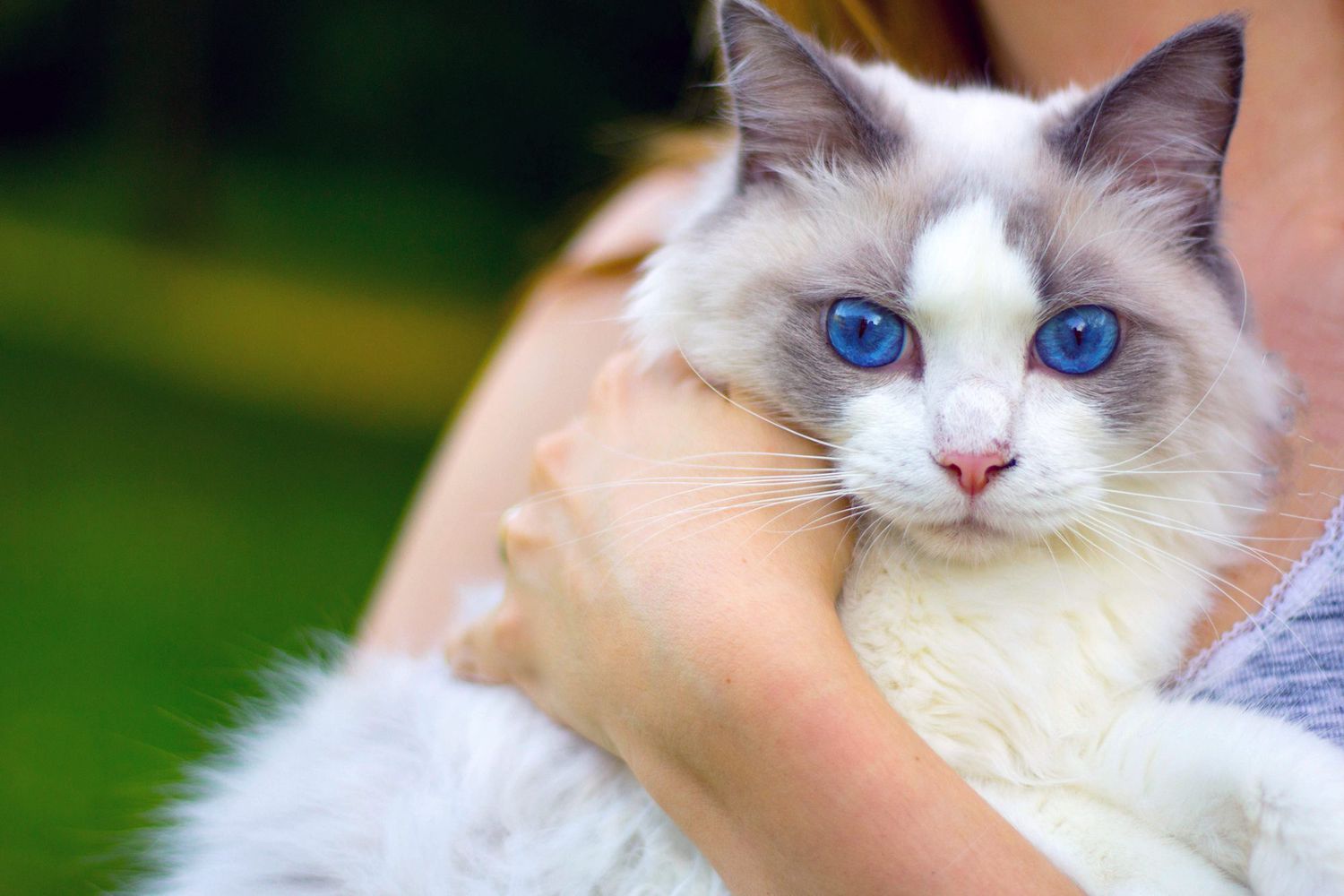Calico cats are known for their colorful coats that consist of three different colors: white, black, and orange calico cat with blue eyes. They are not a specific breed, but rather a result of a genetic mutation that affects the distribution of pigments in their fur.
Calico cats are usually female, as the gene that determines their color pattern is on the X chromosome. However, Calico cats with blue eyes are very rare in calico cats, as they are caused by another gene that is usually linked to white fur.
Only a few breeds, such as the Ojos Azules, can produce calico blue eyes of any fur color. These cats are highly sought after for their striking appearance and unique personality. Some examples of famous blue-eyed calico cats are Nala, the world’s most-followed cat on Instagram, and Tama, the station master cat who boosted the tourism of a Japanese railway line.
Genetics of Calico Color Pattern and Calico Cat with Blue Eyes Gene
Calico cats are known for their colorful coats that consist of three different colors: white, black, and orange. They are not a specific breed, but rather a result of a genetic mutation that affects the distribution of pigments in their fur.
Blue eyes are very rare in calico cats, as they are caused by another gene that is usually linked to white fur. In this article, we will discuss how these genes work and why they produce such unique and diverse features in calico cats.
Calico Color Pattern
The color pattern of calico cats is determined by two genes: the OCA2 gene and the X chromosome. The OCA2 gene codes for a protein called P protein, which is involved in the production of melanin, a pigment that controls the color of the skin, eyes, and hair. The X chromosome carries a gene that can be either black or orange, depending on the parent1.
Calico cats have two X chromosomes, one from each parent, and each X chromosome carries a gene that codes for either black or orange pigment. However, only one X chromosome can be active in each cell, while the other one is inactivated and forms a Barr body. This process is called lyonization and it happens randomly during embryonic development2.
As a result, each cell expresses either black or orange pigment, depending on which X chromosome is active. The white patches are caused by the dominant white gene, which blocks out other color genes. The distribution of these patches creates the unique and diverse color pattern of calico cats.
Why Blue Eyes are Uncommon in Calico Cats and What Breeds Can Have Them
Calico cats are known for their colorful coats that consist of three different colors: white, black, and orange. They are not a specific breed, but rather a result of a genetic mutation that affects the distribution of pigments in their fur.
Blue eyes are very rare in calico cats, as they are caused by another gene that is usually linked to white fur. This article will explain why blue eyes are uncommon in calico cats and what breeds can have them.
The Genetics of Calico Color Pattern and Calico Cat with Blue Eyes Gene
The color pattern of calico cats is determined by two genes: the OCA2 gene and the X chromosome. The OCA2 gene codes for a protein that is involved in the production of melanin, a pigment that controls the color of the skin, eyes, and hair. The X chromosome carries a gene that can be either black or orange, depending on the parent.
Calico cats have two X chromosomes, one from each parent, and each X chromosome carries a gene that codes for either black or orange pigment. However, only one X chromosome can be active in each cell, while the other one is inactivated and forms a Barr body. This process is called lyonization and it happens randomly during embryonic development.
As a result, each cell expresses either black or orange pigment, depending on which X chromosome is active. The white patches are caused by the dominant white gene, which blocks out other color genes. The distribution of these patches creates the unique and diverse color pattern of calico cats.
Blue eyes are caused by a lack of pigment in the iris, which makes the eyes appear clear and reflect the blue light. Blue eyes are more common in white cats, as they are usually linked to the dominant white gene that blocks out other color genes. However, blue eyes can also be found in some breeds that can produce calico cats, such as the Siamese, Ragdoll, Persian, and Ojos Azules.
The Ojos Azules breed is the only one that can produce blue-eyed calico cats of any fur color, due to a mutation in the gene that controls eye and fur color. This mutation allows them to have blue eyes without affecting their fur color, making them unique and rare. Blue eyes can range from a pale sky blue to a deep sapphire blue.
The Rarity and Beauty of Blue-Eyed Calico Cats
Blue-eyed calico cats are very rare and highly sought after by cat lovers. They are estimated to occur in only one out of every 10,000 calico cats. This is because the combination of genes that produces both the calico color pattern and the blue eye color is very unlikely to happen.
Blue-eyed calico cats are also very beautiful and striking. They have a contrast between their bright eyes and their colorful fur that makes them stand out from other cats. They also have their personality and characteristics that make them wonderful companions.
How to Find or Adopt a Blue-Eyed Calico Cat
If you are interested in finding or adopting a blue-eyed calico cat, you may have to search online for reputable breeders or rescue organizations that specialize in rare or exotic cats. You may also visit your local shelter or animal control and look for a calico cat with blue eyes.
However, finding or adopting a blue-eyed calico cat can be challenging and expensive. They are very scarce and not fully recognized by some cat associations. They may also have some health issues and genetic risks associated with their condition. Therefore, you should do your research before getting a blue-eyed calico cat and consult a veterinarian for advice.
Characteristics and Personality of a Calico Cat with Blue Eyes and How to Care for Them
Calico cats are known for their colorful coats that consist of three different colors: white, black, and orange. They are not a specific breed, but rather a result of a genetic mutation that affects the distribution of pigments in their fur. Blue eyes are very rare in calico cats, as they are caused by another gene that is usually linked to white fur.
Physical Features
Blue-eyed calico cats have a contrast between their bright eyes and their colorful fur that makes them stand out from other cats. They can have different shades of blue eyes, ranging from a pale sky blue to a deep sapphire blue.
Their fur can have different combinations of white, black, and orange patches, or lighter shades of cream, blue-gray, and peach. They can also have different coat lengths, depending on their breed and genetics.
Personality Traits
Blue-eyed calico cats have their personality and characteristics that make them wonderful companions. They are often described as sassy, spunky, bold, affectionate, independent, and loyal.
They love to be around people and are always eager to please. They are also very playful, and they often enjoy chasing toys or playing games of fetch. They are intelligent, curious, and adaptable to their owners and environment.
Care Tips
Blue-eyed calico cats require special care and attention to keep them healthy and happy. Here are some pointers on taking good care of them:
- Groom their fur regularly to prevent mats, tangles, and hairballs. Use a brush or comb that suits their coat length and texture.
- Provide them with a balanced diet and fresh water. Avoid foods that contain artificial colors or preservatives, as they may affect their fur or eye color.
- Keep them indoors or supervised outdoors. Blue-eyed calico cats are very rare and highly sought after by cat lovers. They may also have some health issues and genetic risks associated with their condition. Therefore, they must be protected from predators, thieves, or accidents.
- Stimulate their mental and physical needs with toys and games. Blue-eyed calico cats are very active and smart. They need to exercise their body and mind to prevent boredom or stress.
- Visit a veterinarian regularly for check-ups and vaccinations
Comparing and Contrasting Blue-Eyed Calico Cats with Other Types of Calico Cats
Calico cats are known for their colorful coats that consist of three different colors: white, black, and orange. They are not a specific breed, but rather a result of a genetic mutation that affects the distribution of pigments in their fur. Blue eyes are very rare in calico cats, as they are caused by another gene that is usually linked to white fur1. In this article, we will compare and contrast blue-eyed calico cats with other types of calico cats, such as dilute, patched tabby, or male calicos.
Appearance
The most obvious difference between blue-eyed calico cats and other types of calico cats is their eye color. Blue-eyed calico cats have bright blue eyes that contrast with their colorful fur, while other types of calico cats have green, orange, or odd eyes2.
Blue-eyed calico cats can have different shades of blue eyes, ranging from a pale sky blue to a deep sapphire blue. Another difference is their fur color and pattern. Blue-eyed calico cats can have different combinations of white, black, and orange patches, or lighter shades of cream, blue-gray, and peach.
They can also have different coat lengths, depending on their breed and genetics. Dilute calico cats have softer and lighter colors than regular calico cats, such as gray, cream, and peach4. Patched tabby calico cats have stripes or spots on their patches of color. Male calico cats are very rare and have an extra X chromosome that causes them to have both black and orange genes.
Personality
Blue-eyed calico cats have personalities and characteristics that make them wonderful companions. They are often described as sassy, spunky, bold, affectionate, independent, and loyal. They love to be around people and are always eager to please. They are also very playful, intelligent, curious, and adaptable to their owners and environment.
Other types of calico cats may have similar or different personalities depending on their breed and environment. Dilute calico cats may be more calm and gentle than regular calico cats. Patched tabby calico cats may be more outgoing and adventurous than other calico cats. Male calico cats may be more docile and friendly than female calico cats.
Care
Blue-eyed calico cats require special care and attention to keep them healthy and happy. They need to be groomed regularly to prevent mats, tangles, and hairballs. They need to be fed a balanced diet and fresh water. They must be kept indoors or supervised outdoors to protect them from predators, thieves, or accidents.
They need to be stimulated mentally and physically with toys and games. They need to visit a veterinarian regularly for check-ups and vaccinations. Other types of calico cats may have similar or different care needs depending on their breed and genetics.
Dilute calico cats may need more sun protection than regular calico cats because of their lighter colors. Patched tabby calico cats may need more scratching posts than other calico cats because of their tabby instincts. Male calico cats may need more health monitoring than female calico cats because of their genetic risks.
What Eye Color is Common in Calico Cats?
Calico cats are known for their colorful coats that consist of three different colors: white, black, and orange. They are not a specific breed, but rather a result of a genetic mutation that affects the distribution of pigments in their fur.
Calico cats can have different eye colors, depending on their breed and genetics. Some eye colors are more common than others, and some are very rare and unique. In this article, we will explore the different eye colors that calico cats can have and their rarity.
Calico Cat with Blue Eyes
Blue eyes are caused by a lack of pigment in the iris, which makes the eyes appear clear and reflect the blue light. Blue eyes are more common in white cats, as they are usually linked to the dominant white gene that blocks out other color genes. However, blue eyes can also be found in some breeds that can produce calico cats, such as the Siamese, Ragdoll, Persian, and Ojos Azules.
The Ojos Azules breed is the only one that can produce blue-eyed calico cats of any fur color, due to a mutation in the gene that controls eye and fur color. Blue eyes can range from a pale sky blue to a deep sapphire blue.
Calico Cat with Green Eyes
Green eyes are caused by a moderate amount of pigment in the iris, which gives the eyes a green hue. Green eyes can vary from a green with yellow undertones to a true green and a green mixed with shades of blue. Green eyes are found in many breeds that can produce calico cats, such as the Egyptian Mau, Havana, Norwegian Forest Cat, and British Shorthair. Green eyes can also have flecks of gold or yellow within the iris.
Calico Cat with Orange Eyes
Orange eyes are caused by a high amount of pigment in the iris, which gives the eyes an orange or amber color. Orange eyes can also be called copper or gold eyes. Orange eyes are common in breeds that have orange or red fur, such as the Abyssinian, Somali, and Turkish Angora. However, orange eyes can also be seen in some calico cats, especially those that have more orange patches on their fur.
Calico Cat with Odd-Eyes
Odd eyes are when a cat has two different eye colors, such as one blue and one green eye. Odd eyes are caused by a gene that affects the distribution of pigment in one eye, resulting in a lack or excess of pigment. Odd eyes are rare in cats, but they are more common in white cats or cats with white patches on their face.
Can Calico Cats Be Male Too?
Calico cats are known for their colorful coats that consist of three different colors: white, black, and orange. They are not a specific breed, but rather a result of a genetic mutation that affects the distribution of pigments in their fur.
Calico cats are usually female, as the gene that determines their color pattern is on the X chromosome. However, male calico cats are not an impossibility. They do exist, but they are quite rare—only one in 3000 calico cats is male.
Many people mistakenly think that calico cats are usually female since male calico cats are uncommon. In this article, we will explore the genetics, characteristics, and health issues of male calico cats.
Genetics of Calico Cats and Male Calicos
On the X chromosome is the gene that controls how cats exhibit the color orange. Any cat, male or female, can be orange or black because the gene that controls those colors is on the X chromosome.
Females can have both colors, because they have two X chromosomes, one from each parent. Males, who have one X and one Y chromosome, can only have one color gene unless they have a genetic abnormality.
Given that a cat needs two X chromosomes to be classified as a calico or tortoiseshell, the cat will almost certainly be female.
Three sex chromosomes—two Xs and one Y (male)—are present in cats that exhibit the calico pattern. A genetic oddity known as the XXY combination is often seen in cats (and sometimes in people, too).
You may be staring at a unique cat: a male calico cat if both X chromosomes have the calico blueprint. The black gene can be found on one X chromosome in these uncommon XXY male calico cats with Klinefelter’s disease, while the orange gene is found on the other X chromosome. This allows them to provide the
How to Train a Calico Cat with Blue Eyes
Calico cats are known for their colorful coats that consist of three different colors: white, black, and orange. They are not a specific breed, but rather a result of a genetic mutation that affects the distribution of pigments in their fur1. Blue eyes are very rare in calico cats, as they are caused by another gene that is usually linked to white fur. Only a few breeds, such as the Ojos Azules, can produce blue-eyed calico cats of any fur color.
These cats are highly sought after for their striking appearance and unique personality. But how can you train a blue-eyed calico cat? Here are some steps you can follow to teach your cat some basic commands and behaviors.
Choose the Right Rewards
Calico cats love food, so use treats as rewards for good behavior. You can also use toys, praise, or petting as rewards, depending on what your cat likes. Make sure to give the reward immediately after your cat performs the desired behavior so that they can associate it with a positive outcome.
Start with Simple Commands
Teach your cat basic commands such as “sit”, “come”, or “stay” using a clicker or a marker word. Click or say the word when your cat performs the desired behavior, then give a reward. Repeat this until your cat learns the association. You can also use hand signals or gestures to communicate with your cat.
Gradually Increase the Difficulty
Once your cat masters a command, you can add more challenges, such as increasing the distance, duration, or distraction. You can also teach your cat more advanced commands, such as “rollover”, “high five”, or “fetch”. Remember to be patient and consistent with your training, and always end on a positive note.
Use Deterrents for Bad Behavior
Have you had enough of your calico cat’s constant scratching and furniture-destroying behavior? You can use deterrents such as spray bottles, double-sided tape, or citrus peels to discourage your cat from unwanted behaviors. You can also provide your cat with alternative outlets for their instincts, such as scratching posts, toys, or catnip.
Conclusion
Blue-eyed calico cats are a rare and beautiful sight that fascinates many cat lovers. They are the result of a combination of genes that affect their fur color and eye color, making them unique and diverse. The Ojos Azules breed is the only one that can produce blue-eyed calico cats of any fur color, but they are also very scarce and have some health risks.
Blue-eyed calico cats have personalities and characteristics that make them wonderful companions, but they also require special care and attention. If you are interested in finding or adopting a calico cat with blue eyes, you can search online for reputable breeders or rescue organizations, or visit your local shelter and look for a calico cat with blue eyes.
You can also appreciate the diversity and beauty of calico cats by learning more about their genetics, history, and culture. Remember, blue-eyed calico cats are not just a pretty face, they are also living miracles.
FAQs About A Calico Cat With Blue Eyes
1- Why are calico cats with blue eyes so rare?
Answer: Calico cats with blue eyes are rare due to the specific combination of genes required for both the calico color pattern and blue eye color. The Ojos Azules breed is the exception, as they can produce blue-eyed calico cats of any fur color.
2- What determines the color pattern of calico cats?
Answer: The color pattern of calico cats is determined by the OCA2 gene and the X chromosome. The OCA2 gene codes for a protein involved in melanin production, while the X chromosome carries a gene for either black or orange pigment. Lyonization, a process during embryonic development, randomly activates one X chromosome in each cell, resulting in a unique color pattern.
3- Why are blue eyes uncommon in calico cats, and which breeds can have them?
Answer: Blue eyes are rare in calico cats as they are usually linked to the dominant white gene. Breeds like Siamese, Ragdoll, Persian, and Ojos Azules, particularly known for producing calico cats with blue eyes, possess a genetic mutation allowing this unique eye color.
4-How rare are blue-eyed calico cats, and what makes them sought after?
Answer: Blue-eyed calico cats are estimated to occur in only one out of every 10,000 calico cats. Their rarity, combined with the striking contrast between their bright eyes and colorful fur, makes them highly sought after by cat lovers.
5- Can calico cats be male, and what genetic rarity allows for male calico cats?
Answer: Calico cats are usually female due to the gene governing color patterns being on the X chromosome. However, male calico cats, a rarity occurring in one in 3000 calico cats, have three sex chromosomes (XXY), allowing them to showcase the tri-color calico pattern.










